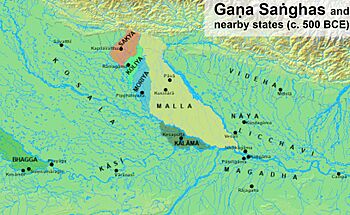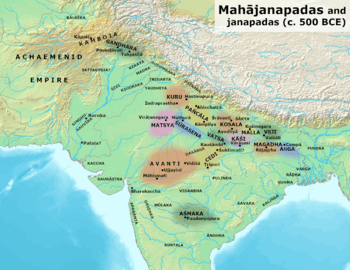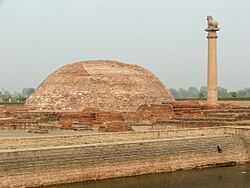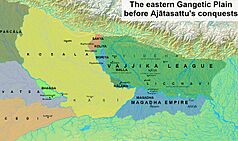Vajjika League facts for kids
Quick facts for kids
Vajjika Confederacy
Vṛji
|
|||||||||
|---|---|---|---|---|---|---|---|---|---|
| c. 6th century BCE–c. 468 BCE | |||||||||

The constituent tribes of the Vajjika League, Licchavi, Videha, and Nāya, among the Gaṇasaṅghas
|
|||||||||

Vajji (the Licchavika dependencies within the Vajjika League), Malla, and other Mahajanapadas in the Post Vedic period
|
|||||||||
| Capital | Vesālī | ||||||||
| Common languages | Prakrit Sanskrit |
||||||||
| Religion | Historical Vedic religion Buddhism Jainism |
||||||||
| Demonym(s) | Vajjika | ||||||||
| Government | Republic (Gaṇasaṅgha) | ||||||||
| Gaṇa Mukhya | |||||||||
| Historical era | Iron Age | ||||||||
|
• Established
|
c. 6th century BCE | ||||||||
|
• Conquered by Ajātasattu of Magadha in 484–468 BCE
|
c. 468 BCE | ||||||||
|
|||||||||
| Today part of | India Nepal |
||||||||
The Vajjika League was an ancient group of tribes in north-east South Asia. It existed during the later Iron Age, a time when people started using iron tools. This league was also known as the Vajji or Vriji Confederacy. It was a type of government called a Republic, where leaders were chosen by the people, not born into power.
Contents
What's in a Name?
The Vajjika League got its name from one of its main tribes, the Vajjikas. This tribe was once very strong in the area around the league's capital city, Vesālī. A Chinese traveler named Xuanzang said that people in northern South Asia called it Saṃvajji. This means "united Vajjis," which makes sense for a group of tribes working together!
Who Were the Tribes in the League?
The Vajjika League was made up of several tribal states. These states were like small republics, meaning they had their own governments where people had a say. The most important tribe in the league was the Licchavikas. Their main city, Vesālī, was the center of the whole league.
Other tribes in the league included:
- The Vaidehas from the Mithila area.
- The Nāyikas from Kuṇḍapura.
- The Vajji tribe itself.
The Mallakas were also part of the Vajjika League. They had two separate republics. Unlike some other tribes, the Mallakas kept their independence and rights within the league. This is why some old texts said the Licchavikas and Mallakas were important republican states.
Some scholars used to think the league had eight clans. This idea came from a misunderstanding of an old Buddhist text. The text mentioned "aṭṭhakulika," which means "heads of eight leading families," not "eight tribes." So, it was about important families in Vesālī, not different tribes.
How the League Was Organized
The Vajjika League was run by the Vajjika Council. This council had eighteen members. Nine of these members were from the leading Licchavika tribe. The other nine members came from the Videha, Nāya, Vajji, and Malla tribes.
Since the Licchavikas were the main tribe, their capital city, Vesālī, was the league's headquarters. The Licchavika army also served as the Vajjika army. However, the other tribes in the league also had to provide soldiers when needed.

Where Was the Vajjika League Located?
The Vajjika League was located in a region surrounded by natural borders.
- To the north were the Himālaya mountains.
- To the east was the Mahānadī river.
- To the south was the Gaṅgā river.
- To the west was the Sadānirā river.
Within the league, the Licchavikas lived in the southwest. This was just north of the Gaṅgā river and east of the Sadānirā river.
The Vaidehas lived near the Himālaya mountains. Their land was between the Sadānirā and Kauśikī rivers. Today, this area includes parts of Nepal and the northern part of Bihār in India.
The Nāyikas lived in a smaller area. Their capital was a town called Kuṇḍagāma or Kuṇḍapura. This town was close to Vesālī, the capital of the Licchavikas and Vajjikas.
A Look at History
The Vajjika League was formed in a region that used to be the Mahā-Videha kingdom. This kingdom was founded by the Vaideha tribe. It was located in the eastern Gangetic plain. Around 800 BCE, the Mahā-Videha kingdom was established. It stretched between the Sadānirā and Kauśikī rivers, and from the Ganges river to the Himālaya mountains.
Around the 7th or 6th century BCE, the Licchavikas invaded the Mahā-Videha kingdom. They took over the Vaideha capital, Mithilā. The Licchavikas were a republican tribe. They peacefully changed the Vaideha kingdom from a monarchy (ruled by a king) to a republic.
To deal with the growing power of Magadha to the south, the Licchavikas moved their main city to Vesālī. They made Vesālī their capital and a strong center. The new Videha republic then existed in a smaller area around Mithilā. Many Vaideha nobles joined the Licchavikas in Vesālī. They became part of the Licchavika ruling assembly.
Once settled in Vesālī, the Licchavikas created a state called a gaṇasaṅgha. This was an aristocratic oligarchic republic. This means a small group of noble families held the power. The Licchavikas became the most powerful group in the region. They formed the Vajjika League. It was named after the Vajji tribe, who were powerful in the Vesālī area. The Vajji tribe was one of the league's founding members.
The Videha republic was governed by an assembly of nobles. They ruled under the guidance of the Licchavika Assembly. This meant the Videha republic had some freedom in its local matters. But Licchavi fully controlled its foreign policy. The Nāyikas were another republic in the league. They also had freedom in their internal affairs. However, the Vajjika League handled their war and foreign policies.
The Licchavikas and the Mallakas were seen as important republics. Both Mallaka republics joined the Vajjika League. They did this to protect themselves from common dangers. They had friendly relations with the Licchavikas, Vaidehas, and Nāyikas. However, sometimes small disagreements happened between these republics. Unlike the Vaidehas and Nāyikas, the Mallakas kept their full independence within the league.
During the 6th century BCE, the leader of the Licchavikas was Ceṭaka. He was also the head of the Vajjika League Council. Ceṭaka's sister, Trisalā, married the Nāyika leader Siddhārtha. This marriage was important because Siddhārtha's tribe was located near Vesālī. Siddhārtha was also a member of the Vajjika Council. Their son, Mahāvīra, became the 24th great teacher of Jainism.
Ceṭaka became a follower of his nephew Mahāvīra. This made Vesālī a center for Jainism. Ceṭaka's daughters married important leaders. This helped spread Jainism across northern South Asia. For example, his daughter Cellaṇā married King Bimbisāra of Magadha.
After the death of the Buddha, the Licchavikas and Mallakas claimed parts of his relics. The Vaidehas and Nāyikas did not make claims. This was because they were under the Licchavikas and did not have their own full independence.
The Vajjika League and Magadha
(Malla shown within the Vajjika League)
The Vajjika League, led by the Licchavikas, first had good relations with their neighbor, the kingdom of Magadha. King Bimbisāra of Magadha was married to a princess from Vesālī. However, there were sometimes disagreements. For example, they competed over the Buddha's relics after his death.
At one point, the Licchavikas even entered Magadha's territory. Eventually, relations between Magadha and Licchavi became very bad. This was due to a serious offense by the Licchavikas against King Bimbisāra.
The problems continued when Ajātasattu became king of Magadha. He was Bimbisāra's son. The Licchavikas supported a revolt against Ajātasattu. This revolt was led by his younger step-brother, Vehalla. Vehalla was also Bimbisāra's son. Bimbisāra had wanted Vehalla to be king instead of Ajātasattu. The Licchavikas tried to help Vehalla become king. They let him use their capital, Vesālī, as a base for his revolt.
After the revolt failed, Vehalla went to Vesālī for safety. Ajātasattu tried many times to make peace with the Vajjika League. But his attempts failed. So, in 484 BCE, he declared war on the Vajjika League.
One reason for the war was a border post called Koṭigāma. The Vajjika League would collect all valuable goods from there. They left nothing for Magadha. Ajātasattu wanted to destroy the Vajjika League in return. He also wanted to control the land that was once the Mahā-Videha kingdom. This land was now part of the Vajjika League.
Another reason for the conflict was the different types of government. Magadha was a monarchy, ruled by a king. The Vajjika League was a republic. This was similar to how the ancient Greek kingdom of Sparta was against the democratic government in Athens.
The Vaidehas, Nāyikas, and Mallakas were also threatened by Ajātasattu. The Vajjika League leader, Ceḍaga, held meetings with the Licchavika and Mallaka leaders. They planned how to fight Magadha. So, the Vaidehas, Nāyikas, and Mallakas fought alongside the Vajjika League.
At first, the Vajjika League's army was too strong for Ajātasattu. He had to use clever plans and tricks for ten years. Finally, by 468 BCE, he defeated the Vajjika League. He took over their lands, including Licchavi, Videha, and Nāya. These areas became part of the Magadha kingdom. The Mallakas also joined Magadha's empire. They were allowed some local control. But they stopped being a separate republic later, during the Maurya dynasty. Even after their defeat, the Licchavikas continued to exist. They kept some local control under Magadha's rule. For example, the Licchavika Council created a festival to remember the death of the Jain teacher Mahāvīra.
See also
- Mahajanapada
- History of India
- History of Hinduism
- List of Indian monarchs
- History of Mithila Region



